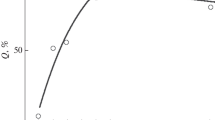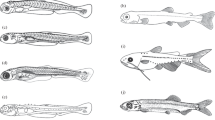Abstract
The diurnal rhythm of schooling behavior of fish closely correlates with changes in illumination and with the ability of individuals to use their vision for coordinated swimming. There is a threshold level of illumination, below which school contacts weaken (swimming velocity decreases, the distance between the nearest partners sharply increases, a uniform orientation is completely lost, swimming becomes multidirectional), fish disperse, a school disintegrates. The threshold level of illumination differs in fish of different species and different ages and shifts depending on changes in other external conditions. The breakup of a school occurs when the illumination is sufficient for the visual perception of partners in the school, but insufficient for fast and well-coordinated school reactions. The formation of a school in the morning hours requires higher illumination than for the evening breakup of the school. At night, schooling fish keep apart, reduce motor activity, can be motionless and lie on the ground.



Similar content being viewed by others
REFERENCES
Ali, M.A., The ocular structure retinomotor and photo-behavioral responses of juvenile pacific salmon, Can. J. Zool., 1959, vol. 37, no. 6, pp. 965–996. https://doi.org/10.1139/z59-092
Emery, A.R., Preliminary comparisons of day and night habits of freshwater fish in Ontario lakes, J. Fish. Res. Board Can., 1973, vol. 30, no. 6, pp. 761–774. https://doi.org/10.1139/f73-131
Glass, C.W., Wardle, C.S., and Mojsiewicz, W.R., A light intensity threshold for schooling in the Atlantic mackerel, Scomber scombrus, J. Fish. Biol., 1986, vol. 29, no. sA, pp. 71–81. https://doi.org/10.1111/j.1095-8649.1986.tb05000.x
Gruber, D.F., Phillips, B.T., O’Brien, R., et al., Bioluminescent flashes drive nighttime schooling behavior and synchronized swimming dynamics in flashlight fish, PLOS ONE, 2019, vol. 14, no. 8, Article e0219852. https://doi.org/10.1371/journal.pone.0219852
Harden Jones, F.R., The behaviour of minnows in relation to light intensity, J. Exp. Biol., 1956, vol. 33, no. 2, pp. 271–281. https://doi.org/10.1242/jeb.33.2.271
Helfman, G.S., Twilling activities of yellow perch, Perca flavescens, J. Fish. Res. Board Can., 1979, vol. 36, no. 2, pp. 173–179. https://doi.org/10.1139/f79-027
Higgs, D.M. and Fuiman, L.A., Light intensity and schooling behaviour in larval gulf menhaden, J. Fish. Biol., 1996, vol. 48, no. 5, pp. 979–991. https://doi.org/10.1111/j.1095-8649.1996.tb01491.x
Hunter, J.R., Effects of light on schooling and feeding of jack mackerel, Trachurus symmetricus, J. Fish. Res. Board Can., 1968, vol. 25, no. 2, pp. 393–407. https://doi.org/10.1139/f68-031
Hunter, J. and Nicholl, R., Visual threshold for schooling in northern anchovy Engraulis mordax, Fish. Bull., 1985, vol. 83, no. 3, pp. 235–242.
Ikehara, K., Ecology of mojyako, in Study on the Production Ability and Oceanic Environments, Niigata: Jpn. Sea Nat. Fish. Res. Inst., 1984, pp. 221–233.
John, K.R., Illumination and vision and the schooling behaviour of Astyanax mexicanus (Fillipi), J. Fish. Res. Board Can., 1964, vol. 21, no. 6, pp. 1453–1473. https://doi.org/10.1139/f64-122
Kiselev, O.N. and Solov’ev, B.S., Results of observations of the behavior of fish from a deep-water hydrostat, Vopr. Ikhtiol., 1961, vol. 1, no. 4 (21), pp. 745–751.
Loukashkin, A.S. and Grant, N., Behaviour and reaction of the pacific sardine, Sardinops caerulea (Girard) under the influence of white colored lights and darkness, Proc. Calif. Acad. Sci., 1959, no. 15, pp. 509–548.
Luo, J., Tidal transport of the bay anchovy, Anchoa mitchilli, in darkness, J. Fish. Biol., 1993, vol. 42, no. 4, pp. 531–539. https://doi.org/10.1111/j.1095-8649.1993.tb00357.x
Major, P.F., Predator-prey interactions in schooling fishes during periods of twilight: A study of the silverside Pranesus insularum in Hawaii, Fish. Bull., 1977, vol. 75, no. 2, pp. 415–426.
Manteifel’, B.P., Girsa, I.I., Leshcheva, T.S., and Pavlov, D.S., Diurnal rhythms of nutrition and motor activity of some freshwater predatory fish, in Pitanie khishchnykh ryb i ikh vzaimootnosheniya s kormovymi organizmami (Nutrition of Predatory Fish and Their Relationship with Forage Organisms), Moscow: Nauka, 1965a, pp. 3–81.
Manteifel’, B.P., Girsa, I.I., Leshcheva, T.S., and Pavlov, D.S., Influence of changing illumination on the formation and breakup of schools in fish, Pitanie khishchnykh ryb i ikh vzaimootnosheniya s kormovymi organizmami (Nutrition of Predatory Fish and Their Relationship with Forage Organisms), Moscow: Nauka, 1965b, pp. 83–90.
Pitcher, T.J., Magurran, A.E., and Edwards, J.I., Schooling mackerel and herring choose neighbours of similar size, Mar. Biol., 1985, vol. 86, no. 3, pp. 319–322. https://doi.org/10.1007/BF00397518
Protasov, V.R., Some functional features of vision and their biological significance in the life of nine fish species of the Black Sea, Tr. Inst. Morfol. Zhivotnykh Akad. Nauk SSSR, 1961, vol. 39, pp. 72–95.
Sakakura, Y. and Tsukamoto, K., Age composition in the schools of juvenile yellowtail, Seriola quinqueradiata associated with drifting seaweeds in the East China Sea, Fish. Sci., 1997, vol. 63, no. 1, pp. 37–41. https://doi.org/10.2331/fishsci.63.37
Shaw, E., Minimal light intensity and the dispersal of schooling fish, Bull. Inst. Océanogr. Monaco, 1961a, vol. 1213, pp. 1–8.
Shaw, E., The development of schooling in fishes, Physiol. Zool., 1961b, vol. 34, no. 4, pp. 263–272. https://doi.org/10.1086/physzool.34.4.30161205
Smith, G.W., Glass, C.W., Johnstone, A.D.F., and Mojsiewicz, W.R., Diurnal patterns in the spatial relationships between saithe, Pollachius virens, schooling in the wild, J. Fish. Biol., 1993, vol. 43, no. sA, pp. 315–325. https://doi.org/10.1111/j.1095-8649.1993.tb01195.x
Steven, D.M., Studies in the shoaling behaviour of fish. Responses of two species to changes in illumination and to olfactory stimuli, J. Exp. Biol., 1959, vol. 36, no. 2, pp. 261–280. https://doi.org/10.1242/jeb.36.2.261
Woodland, D.J., Cabanban, A.S., Taylor, V.M., and Taylor, R.J., A synchronized rhythmic flashing light display by schooling Leiognathus splendens (Leiognathidae: Perciformes), Mar. Freshw. Res., 2002, vol. 53, no. 2, pp. 159–162. https://doi.org/10.1071/MF01157
ACKNOWLEDGMENTS
The authors express their sincere gratitude to A.A. Kazhlaev, L.S. Alekseeva and A.S. Patseva (Moscow State University), who provided great assistance in preparing the article for publication. The authors are sincerely grateful to P.I. Kirillov (Institute of Ecology and Evolution, Russian Academy of Sciences) for careful and constructive editing of the text and illustrations, which improved the quality of the article.
Funding
The article was prepared within the framework of scientific projects of the state assignment of the Moscow State University No. 121032300100-5 and the Institute of Ecology and Evolution, Russian Academy of Sciences No. 121122300056-3 in the Unified State Information System for Accounting the Results of Civil Research, Development and Technological Works.
Author information
Authors and Affiliations
Corresponding author
Ethics declarations
ETHICS APPROVAL AND CONSENT TO PARTICIPATE
All applicable international, national, and/or institutional guidelines for the care and use of animals were followed.
CONFLICT OF INTEREST
The author of this work declares that he has no conflicts of interest.
Additional information
Translated by S. Avodkova
Publisher’s Note.
Pleiades Publishing remains neutral with regard to jurisdictional claims in published maps and institutional affiliations.
Rights and permissions
About this article
Cite this article
Kasumyan, A.O., Pavlov, D.S. Diurnal Rhythm of Schooling Behavior of Fish. J. Ichthyol. 63, 1273–1278 (2023). https://doi.org/10.1134/S003294522307007X
Received:
Revised:
Accepted:
Published:
Issue Date:
DOI: https://doi.org/10.1134/S003294522307007X




